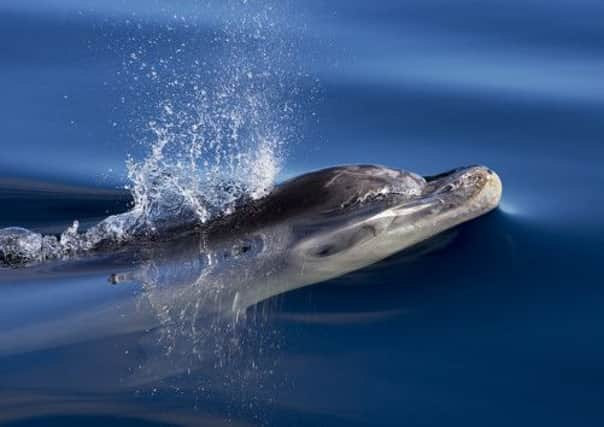Marine expert tells of Moray Firth dolphin attack


Alan Airey, a regional co-ordinator for the marine research charity Sea Watch Foundation, said he watched through binoculars as the “tight formation” of highly organised bottlenose dolphins attacked a smaller harbour porpoise off the Covesea Skerries near Lossiemouth.
A rise in porpoise deaths, linked to a spate of attacks by their larger cousins, the bottlenose dolphin, was first reported in 2007 by a team of marine researchers, led by scientists at Aberdeen University. It revealed that nearly two-thirds of dead porpoises washed up on the Scottish coast appeared to have been killed by dolphin attack.
Advertisement
Hide AdAdvertisement
Hide AdMr Airey said that, while attacks on porpoise by bottlenose dolphins were not unusual, he had never before witnessed such an organised attack by a pod of cetaceans.
Charging
He explained that the attack happened while he was watching around eight bottlenose dolphins, and a mother and calf, leaping, feeding and surfing on the west side of the skerries on Friday 24 May, just as the Bank Holiday began.
While the mother and calf remained feeding, slowly the behaviour of the other dolphins dramatically changed.
He said: “I also saw a porpoise, quite close in, heading east. Slowly the dolphins moved further west. Then at about 4.15pm, the eight dolphins started charging about shoulder to shoulder, and I realised they were attacking at least one porpoise. I saw a porpoise had been tossed in the air, with the pack all diving in after it.
“Then I saw a porpoise swimming for its life right in front of the dolphin ‘pack’, the dolphins would surge forward as one as if trying to drown it by forcibly pushing it under, and then I saw another chase which resulted in a porpoise being tossed in the air again.”
Victim
Mr Airey continued: “It was hard to judge whether it was just one porpoise that was been ‘played’ with, or more than one porpoise. I’ve seen bottlenose attacks on porpoise before but not quite like this with such a tight ‘pack’ of dolphins.”
A spokeswoman for the charity said: “The attack took place about 800 metres from the coast. Later that day a group of more than 50 bottlenose dolphins were reported at Burghead and later the same evening a minke whale was seen in the area. There have been a couple of dead porpoises found at Covesea and Burghead over the last week, although whether they too were victim to bottlenose attacks is not yet known.”
Danielle Gibas, the Sea Watch sightings officer said: “We cannot be sure why bottlenose dolphins attack harbour porpoise. There have been several hypotheses ranging from misdirected infanticide to pure aggression by males, but it may well be simply when the two species interfere with one another for space or food.
Crushing
Advertisement
Hide AdAdvertisement
Hide Ad“In any event, this was an extraordinary and graphic account of bottlenose dolphin behaviour, which has rarely been witnessed at firsthand. Interestingly, exactly the same technique for killing a porpoise was witnessed by Sea Watch director, Peter Evans, off Anglesey a few years ago when a pack of three dolphins pursuing the porpoise, tossing it into the air repeatedly, then jumping on the animal, in that instance crushing its vertebrae and puncturing the lungs.”
The Moray Firth is home to the world’s most northerly bottlenose dolphin population. There is an estimated population of 130 bottlenoses dolphins, known locally as “loupers” or “tumblers”. A report, commissioned by the Moray Firth Partnership, has shown that their presence in the firth is worth at least £4million to the local economy and supports more than 200 jobs in the tourism sector.
Reporting the first attacks, Dr Colin MacLeod, a research fellow at the University of Aberdeen, said: “We do not fully understand why dolphins attack porpoises, but we know it is not for food, as the dolphins abandon the carcase once the porpoise is dead.”